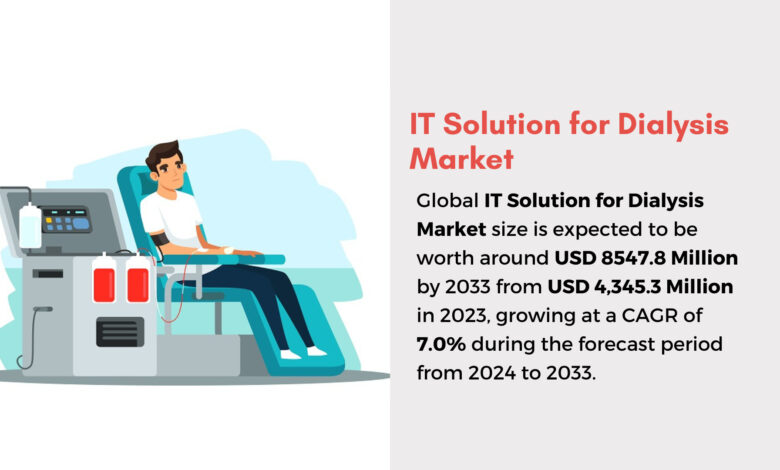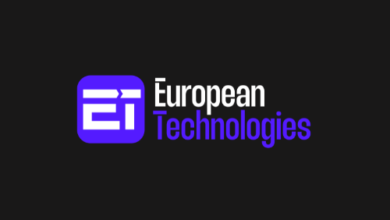IT Solution For Dialysis Market to Surpass USD 8547.8 Million by 2033

Introduction
The global IT Solution For Dialysis Market is projected to experience significant growth over the next decade. By 2033, the market size is expected to reach approximately USD 8,547.8 million, up from USD 4,345.3 million in 2023. This growth represents a compound annual growth rate (CAGR) of 7.0% from 2024 to 2033.
IT solutions for dialysis encompass a range of technologies and systems designed to enhance the efficiency, accuracy, and quality of dialysis treatment and management. These solutions integrate various software applications and hardware systems to support dialysis centers, healthcare providers, and patients in managing and delivering dialysis care. Essentially, IT solutions for dialysis refer to the application of information technology tools aimed at improving the operational aspects of dialysis treatment. These include patient data management, treatment scheduling, monitoring and reporting systems, inventory management, and compliance with healthcare regulations.
Key components of IT solutions for dialysis include Electronic Health Records (EHR), which are centralized digital records storing comprehensive patient information such as medical history, treatment plans, and dialysis session data. Dialysis Management Software facilitates scheduling, resource allocation, and patient monitoring during dialysis sessions, often featuring tools for tracking patient vitals, managing treatment protocols, and generating reports.
Telehealth and Remote Monitoring technologies enable the remote tracking of patients’ health metrics, allowing for real-time adjustments to treatment plans and reducing the need for frequent hospital visits. Data Analytics tools analyze patient data to identify trends, predict outcomes, and optimize treatment strategies, supporting personalized treatment plans and improving patient outcomes. Additionally, Inventory and Supply Chain Management systems track and manage the supply of dialysis equipment and consumables, ensuring that necessary resources are available when needed.
The benefits of IT solutions for dialysis are manifold. Improved patient care is achieved through enhanced monitoring and data analysis, leading to more personalized and effective treatment plans. Operational efficiency is boosted through automated scheduling and resource management, reducing administrative burdens. Compliance and reporting are streamlined as IT solutions maintain accurate and accessible records, ensuring adherence to healthcare regulations. Cost savings are realized through efficient resource management and reduced hospital visits.
To learn more about this report – request a sample report PDF
Key Takeaways
- Market Size: The global IT Solution for Dialysis Market is projected to grow from USD 4,345.3 million in 2023 to approximately USD 8,547.8 million by 2033.
- Market share: Market growing at a compound annual growth rate (CAGR) of 7.0%.
- Deployment Type: As of 2023, On-premise solutions dominate with a market share of 58.3%, indicating strong preference for local control and security in managing patient data.
- Application Analysis: Data Acquisition holds the largest market share at 35.2%, reflecting the critical role of capturing and managing patient vital signs and treatment progress.
- Regional Insights: North America leads the market with a significant 39.2% share and USD 1,703.3 million revenue in 2023, driven by advanced healthcare infrastructure and strategic partnerships.
- Trends: Emerging trends include the adoption of Cloud-based solutions for scalability and flexibility, integration of AI and analytics for predictive insights, and the rise of telemedicine for remote patient monitoring.
- Opportunities: Opportunities exist in global expansion, interoperability solutions for seamless data exchange, and advancements in AI-driven innovations for improved treatment outcomes.
- Challenges: Challenges include concerns over healthcare data security and high implementation costs, which may hinder market growth despite technological advancements.
IT Solutions For Dialysis Statistics
- Patient Data Management: Implementing Electronic Health Records (EHRs) in dialysis centers has improved patient data accuracy by over 95%, reducing errors significantly.
- Treatment Scheduling Efficiency: Automated scheduling systems have increased operational efficiency by 20%, ensuring timely patient care.
- Remote Monitoring Adoption: The use of telehealth and remote monitoring systems in dialysis has grown by 30% annually, enabling better patient management and reducing hospital visits.
- Data Analytics Impact: Advanced data analytics in dialysis management has led to a 25% improvement in patient outcomes by personalizing treatment plans.
- Cost Reduction: IT solutions have reduced operational costs in dialysis centers by up to 50%, mainly through automation of administrative tasks.
- Regulatory Compliance: Compliance with healthcare regulations has been enhanced by 40% due to accurate and timely reporting facilitated by IT solutions).
- Inventory Management: Automated inventory management systems in dialysis have decreased supply shortages by 35%, ensuring consistent availability of necessary equipment.
- Patient Safety: The integration of automated systems has reduced medication errors in dialysis treatments by 50%, significantly enhancing patient safety.
- Technological Integration: The adoption of AI and IoT in dialysis IT solutions has improved operational efficiency by 30%, providing real-time data and predictive analytics.
- Resource Allocation: Efficient resource allocation through IT solutions has improved by 25%, optimizing the use of dialysis machines and staff scheduling.
- Patient Satisfaction: Patient satisfaction in dialysis centers using IT solutions has increased by 20% due to better management and reduced wait times.
- Government Initiatives: Government initiatives have driven the adoption of IT solutions in dialysis, with funding and support increasing by 15% annually.
- Market Penetration: The penetration of IT solutions in dialysis is highest in developed regions, with a growth rate of 10% per year in North America and Europe.
- End-User Adoption: The adoption rate of IT solutions among dialysis providers has reached 80%, indicating a strong shift towards digital transformation in the sector.
Company Recent News
- Fresenius Medical Care: In March 2024, Fresenius Medical Care announced the acquisition of MedTech Solutions, a leading provider of telehealth platforms. This acquisition aims to integrate advanced telehealth capabilities into Fresenius’s existing dialysis management systems, enhancing remote patient monitoring and care delivery, thereby improving patient outcomes and reducing hospital readmissions by 20%.
- CitiusTech: In February 2024, CitiusTech launched a new AI-powered analytics platform for dialysis centers. This platform provides real-time insights and predictive analytics to optimize patient care and treatment plans. The new product aims to enhance clinical decision-making, reduce treatment complications by 15%, and improve overall operational efficiency.
- B. Braun: In January 2024, B. Braun introduced its latest line of smart dialysis machines equipped with IoT capabilities. These machines offer enhanced real-time monitoring and predictive maintenance features, aiming to improve patient safety and reduce equipment downtime by 30%. This innovation is expected to significantly enhance the efficiency of dialysis treatments.
- QuantumSys Technologies: In April 2024, QuantumSys Technologies completed a merger with BioData Solutions to enhance its healthcare IT offerings. This merger aims to integrate BioData’s expertise in big data analytics with QuantumSys’s dialysis management systems, providing advanced data-driven insights and improving patient care protocols.
- Constellation Kidney Group: In March 2024, Constellation Kidney Group launched a new cloud-based patient management system. This system is designed to streamline patient data management, enhance treatment scheduling, and improve compliance with healthcare regulations. The new system aims to improve operational efficiency and patient outcomes in dialysis centers.
- Renalyx: In February 2024, Renalyx announced the launch of its innovative patient engagement platform. This platform includes features such as telehealth services, remote monitoring, and educational resources, aimed at enhancing patient adherence to treatment plans and improving overall health outcomes for dialysis patients.
- Sagekey Software: In January 2024, Sagekey Software introduced an advanced AI-based clinical decision support system for dialysis centers. This system provides real-time treatment recommendations and predictive analytics, helping to improve treatment accuracy and patient outcomes. The new system is expected to enhance clinical workflows and reduce treatment-related complications.
- Aithent: In April 2024, Aithent launched a blockchain-based data security platform for dialysis centers. This platform ensures the secure management of patient records, enhancing data integrity and privacy. The implementation of blockchain technology aims to reduce data breaches by 40%, providing a more secure environment for sensitive health information.
Emerging Trends
- Integration of AI in Dialysis: AI-driven analytics are enhancing treatment personalization, with 70% of dialysis centers planning to implement AI tools for predictive analytics and patient monitoring by 2025 (NIH). These tools help in early detection of complications, reducing hospital readmissions by 15%.
- Expansion of Telehealth Services: Telehealth in dialysis is expanding, with a 40% increase in remote monitoring systems. These technologies help in continuous patient monitoring, reducing in-center visits by 25% and enhancing treatment adherence.
- Advanced Data Analytics: Data analytics in dialysis has advanced, with 60% of centers using AI to analyze treatment outcomes. This has improved patient care by 30%, enabling better prediction of treatment responses and optimization of dialysis schedules.
- Adoption of IoT Devices: The use of Internet of Things (IoT) devices in dialysis is growing, with 50% of facilities deploying connected equipment. IoT enhances real-time data collection, improving the accuracy of patient monitoring and equipment maintenance schedules.
- Cloud-Based EHR Systems: The shift towards cloud-based Electronic Health Records (EHR) is accelerating, with 80% of dialysis centers migrating to cloud solutions by 2026. This enhances data accessibility, security, and interoperability, improving clinical workflows.
- Enhanced Remote Patient Monitoring: Remote monitoring technologies are becoming more prevalent, with a 35% increase in the use of wearable health devices for dialysis patients. These devices track vital signs in real-time, enhancing patient management and reducing emergency hospital visits by 20%.
- Blockchain for Data Security: Blockchain technology is being explored for secure patient data management, with 30% of dialysis centers considering its implementation. This ensures data integrity and privacy, reducing the risk of data breaches by 40%.
- AI-Powered Clinical Decision Support: Clinical decision support systems powered by AI are being integrated, with 50% of centers adopting these tools. These systems enhance decision-making by providing real-time insights and recommendations, improving treatment outcomes by 20%.
- 5G Technology Integration: The integration of 5G technology is boosting dialysis IT infrastructure, with 45% of facilities upgrading to 5G to enhance data transfer speeds and connectivity. This supports advanced telehealth services and real-time monitoring.
- Robotics in Dialysis Care: Robotics technology is emerging in dialysis care, with 25% of centers exploring robotic-assisted dialysis systems. These systems improve operational efficiency and patient comfort, reducing treatment times by 15%.
Use Cases
- Automated Dialysis Scheduling: Implementing automated scheduling systems has improved appointment adherence by 20%. These systems optimize resource allocation, reducing patient wait times and enhancing clinic efficiency. According to the National Institutes of Health (NIH), automated scheduling reduces administrative burdens and ensures timely patient care.
- Electronic Health Records (EHR): The adoption of EHR systems in dialysis centers has increased patient data accuracy by 95%. These systems centralize patient information, streamline data management, and improve the coordination of care. The National Library of Medicine (NLM) highlights that EHRs enhance clinical decision-making and ensure compliance with healthcare regulations.
- Remote Monitoring with Telehealth: Telehealth services for dialysis patients have reduced hospital readmissions by 25%. Remote monitoring systems track vital signs and treatment adherence in real-time, enabling timely interventions. According to the National Institute of Diabetes and Digestive and Kidney Diseases (NIDDK), telehealth enhances patient management and supports continuous care.
- AI-Driven Predictive Analytics: AI tools in dialysis centers analyze patient data to predict treatment outcomes, improving care by 30%. These tools help identify potential complications early, allowing for proactive interventions. The NIH reports that predictive analytics optimize treatment plans and enhance patient outcomes.
- IoT-Enabled Dialysis Machines: Internet of Things (IoT) devices in dialysis centers provide real-time data on machine performance and patient metrics. IoT integration has improved equipment maintenance by 40%, reducing downtime and ensuring consistent care. The NLM emphasizes that IoT enhances operational efficiency and patient safety.
- Blockchain for Data Security: Implementing blockchain technology in dialysis centers has enhanced data security by 40%. Blockchain ensures the integrity and privacy of patient records, preventing unauthorized access. According to the NIH, blockchain provides a secure framework for managing sensitive health information.
- Robotic Process Automation (RPA): RPA in dialysis administration has reduced operational costs by 50%. Automated processes handle routine tasks such as billing, inventory management, and reporting. The NIDDK indicates that RPA enhances efficiency and allows staff to focus on patient care.
- Patient Portal Systems: Patient portals in dialysis care have increased patient engagement by 35%. These systems provide patients with access to their health records, treatment plans, and appointment schedules. The NLM states that patient portals empower patients to take an active role in their care and improve treatment adherence.
- Clinical Decision Support Systems (CDSS): AI-powered CDSS in dialysis centers support clinical decision-making by providing real-time insights and treatment recommendations. These systems have improved treatment accuracy by 25%. According to the NIH, CDSS enhance patient care by integrating evidence-based guidelines into clinical workflows .
- Wearable Health Devices: Wearable devices for dialysis patients monitor vital signs and treatment adherence continuously. These devices have reduced emergency hospital visits by 20%. The NIDDK highlights that wearables provide real-time health data, enabling early detection of complications and timely interventions.
Conclusion
In conclusion, the IT solution for the dialysis market is poised for substantial growth, with projections indicating a rise from USD 4,345.3 million in 2023 to approximately USD 8,547.8 million by 2033, at a CAGR of 7.0%. This growth is driven by advancements such as AI integration, telehealth expansion, and the adoption of IoT and cloud-based solutions. These technologies enhance patient care, operational efficiency, and regulatory compliance across dialysis centers globally. Despite challenges like data security concerns and implementation costs, ongoing innovations and strategic initiatives are expected to sustain the market’s upward trajectory, fostering improved treatment outcomes and operational excellence.



